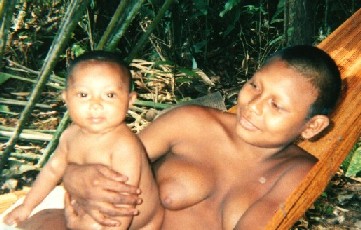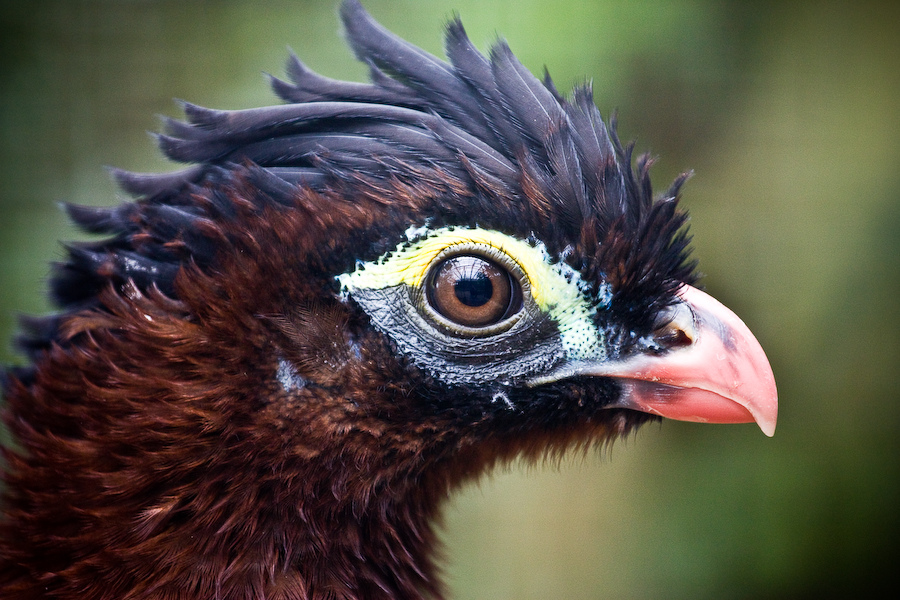|
Nukak
The Nukak people (also Nukak- Makú) live between the Guaviare and Inírida rivers, in the depths of the tropical humid forest, on the fringe of the Amazon basin, in Guaviare Department, Republic of Colombia. They are nomadic hunter-gatherers with seasonal nomadic patterns and practice small-scale shifting horticulture.Mondragón, Héctor 1994 "La defensa del territorio Nukak" en Antropología y derechos Humanos. Memorias del VI Congreso de Antropología en Colombia. Carlos Vladimir Zambrano editor. Universidad de los Andes, p.p. 139 a 155. Bogotá D.C.- They were classified as "uncontacted people" until 1981, and have since lost half of their population primarily to disease. Part of their territory has been used by coca growers, ranchers, and other settlers, as well as being occupied by guerrillas, army and paramilitaries. Responses to this crisis include protests, requests for assimilation, and the suicide of leader Maw-be'. An estimated 210–250 Nukak people live in pr ... [...More Info...] [...Related Items...] OR: [Wikipedia] [Google] [Baidu] |
Nukak Language
The Nukak language ( mbr, Guaviare) is a language of uncertain classification, perhaps part of the macrofamily Puinave-Maku. It is very closely related to Kakwa.Gustavo Politis, ''Nukak: Ethnoarchaeology of an Amazonian People,'' Left Coast Press, Walnut Creek, California (2007) 2009 p.53. Phonology Vowels There are six oral and six nasal vowels. The vowel becomes the labial semivowel in several environments: in postnuclear position (when it appears immediately after the nuclear vowel of a morpheme), before another vowel, and at the beginning of the word or syllable. The semivowel is devoiced (IPA symbol ) if the tone rises and the following vowel is , , . The vowel becomes the palatal semivowel in postnuclear position. Nasalization in Nukak language is a prosodic property of the morpheme that affects all segments within each morpheme except voiceless stops. Each morpheme is either completely nasal or completely oral. Consonants There are eleven consonant phonemes: ... [...More Info...] [...Related Items...] OR: [Wikipedia] [Google] [Baidu] |
Uncontacted People
Uncontacted peoples are groups of indigenous peoples living without sustained contact with neighbouring communities and the world community. Groups who decide to remain uncontacted are referred to as indigenous peoples in voluntary isolation. Legal protections make estimating the total number of uncontacted tribes challenging, but estimates from the Inter-American Commission on Human Rights in the UN and the non-profit group Survival International point to between 100 and 200 tribes numbering up to 10,000 individuals.Report of the Regional Seminar on indigenous peoples in voluntary isolation and in initial contact of the Amazonian Basin and El Chaco, Santa Cruz de la Sierra, Bolivia (20–22 November 2006), presented by the Office of the United Nations High Commissioner for Human Rights (OHCHR) and the International Work Group on Indigenous Affairs (IWGIA), E/C.19/2007/CRP.1, March 28, 2007, para 1. A majority of tribes live in South America, particularly Brazil, where the Brazi ... [...More Info...] [...Related Items...] OR: [Wikipedia] [Google] [Baidu] |
Kãkwã People
Kãkwã, Cacua or Bará-maku is an indigenous people living in northwestern Amazonia, between Vaupés, Querarí and Papuri rivers, in Colombia, close to the border with Brazil, within Vaupés indigenous Resguardo. The Kãkwã are approximately 250 people, who speak their own language, which is part of the Macu family and is closely related to the Nukak language. Each kãkwã is part of an exogamous patrilineal clan. The clans engage in marital exchanges and consider themselves "baih", brothers-in-law or bilateral cross-cousins.Silverwood-Cope, Peter L. (1990). ''Os Makú: Povo cazador no noroeste da Amazònia''. Universidade de Brasília. Originally nomadic hunter-gatherer A traditional hunter-gatherer or forager is a human living an ancestrally derived lifestyle in which most or all food is obtained by foraging, that is, by gathering food from local sources, especially edible wild plants but also insects, fungi, ...s, later subjected to the neighboring ethnic groups, bu ... [...More Info...] [...Related Items...] OR: [Wikipedia] [Google] [Baidu] |
Maku People
Maku (Macu, Máku, Mácu, Makú, Macú) or Maco (Mako, Máko, Macó, Makó) is a pejorative term referring to several hunter-gatherer peoples of the upper Amazon, derived from an Arawakan term ''ma-aku'' "do not speak / without speech". Nimuendajú (1950), for example, notes six peoples of Colombia, Venezuela, and Brazil that are known as 'Maku'. In linguistic literature, the term refers primarily to: * the Nadahup languages, a small language family in Brazil, Colombia, and Venezuela, sometimes disambiguated from other Maku languages as ''Makú'' or ''Macú'', though those forms can apply to any of the languages, or as ''Makuan''. Such languages include Hup, spoken by Hupda, (''Hupdá Makú'', ''Makú-Hupdá'', ''Macú De'') and Guariba Maku * the closely related Nukak Makú and Kakwa (''Macu de Cubeo'', ''Macu de Desano'', ''Macu de Guanano'', ''Macú-Paraná'') * the Maku-Auari language, the 'Maku' of Roraima and the Auari River, a possible language isolate of Brazil and Vene ... [...More Info...] [...Related Items...] OR: [Wikipedia] [Google] [Baidu] |
Guaviare Department
Guaviare () is a department of Colombia. It is in the southern central region of the country. Its capital is San José del Guaviare. Guaviare was created on July 4, 1991, by the new Political Constitution of Colombia. Up until that point, it was a national territory that operated as a commissariat, segregated from territory of the then Commissariat of Vaupés on December 23, 1977. Municipalities # Calamar # El Retorno # Miraflores # San José del Guaviare History Originally inhabited by the indigenous Nukak people, Guaviare was one of the regions colonized during the Amazon rubber boom of the 1910s and 1940s. Many families migrated from the centre of the country, seeking fast revenue and escaping from the bi-partisan violence taking place in other regions of Colombia. Nevertheless, the 'rubber fever' ended quickly, leaving the new inhabitants of Guaviare alone in an immense rainforest difficult to conquer. The boom of cocaine in the second half of the 20th century attracte ... [...More Info...] [...Related Items...] OR: [Wikipedia] [Google] [Baidu] |
Hunter-gatherer
A traditional hunter-gatherer or forager is a human living an ancestrally derived lifestyle in which most or all food is obtained by foraging, that is, by gathering food from local sources, especially edible wild plants but also insects, fungi, honey, or anything safe to eat, and/or by hunting game (pursuing and/or trapping and killing wild animals, including catching fish), roughly as most animal omnivores do. Hunter-gatherer societies stand in contrast to the more sedentary agricultural societies, which rely mainly on cultivating crops and raising domesticated animals for food production, although the boundaries between the two ways of living are not completely distinct. Hunting and gathering was humanity's original and most enduring successful competitive adaptation in the natural world, occupying at least 90 percent of human history. Following the invention of agriculture, hunter-gatherers who did not change were displaced or conquered by farming or pastoralist groups in ... [...More Info...] [...Related Items...] OR: [Wikipedia] [Google] [Baidu] |
Hupdu
The Hupda (also known as Hup, Hupd'äh, or Húpd’əh) are an Amazonian indigenous people who live in Brazil and Colombia. They speak the Hup language. Residence and neighbors The Hupd'äh people live in the region bordered by the rivers Tiquié and Papuri, tributaries that join the left hand bank of the river Vaupés in the Upper Rio Negro region of the state of Amazonas in Brazil and the Department of Vaupés in Colombia. They are known as part of the Naduhup language family, and have been in contact with the frontiers of colonization since the 18th century. There are records of countless epidemics of measles, smallpox, and influenza, which decimated the population. Currently they are distributed in approximately 35 villages (local groups) estimated at a total of 1500 individuals. The Hupda villages are, in general, close to areas of Tukanoan, Tariana, Tuyuka and Piratapuyo population, populations which speak languages of the Tukanoan language family, living near the ... [...More Info...] [...Related Items...] OR: [Wikipedia] [Google] [Baidu] |
Muscovy Duck
The Muscovy duck (''Cairina moschata'') is a large duck native to the Americas, from the Rio Grande Valley of Texas and Mexico south to Argentina and Uruguay. Small wild and feral breeding populations have established themselves in the United States, particularly in Florida, Louisiana, Massachusetts, the Big Island of Hawaii, as well as in many other parts of North America, including southern Canada. Feral Muscovy ducks are found in New Zealand, Australia, and in parts of Europe. It is a large duck, with the males about long, and weighing up to . Females are noticeably smaller, and only grow to , roughly half the males' size. The bird is predominantly black and white, with the back feathers being iridescent and glossy in males, while the females are more drab. The amount of white on the neck and head is variable, as well as the bill, which can be yellow, pink, black, or any mixture of these colors. It may have white patches or bars on the wings, which become more noticeable durin ... [...More Info...] [...Related Items...] OR: [Wikipedia] [Google] [Baidu] |
Chachalaca
Chachalacas are galliform birds from the genus ''Ortalis''. These birds are found in wooded habitats in the far southern United States (Texas), Mexico, and Central and South America. They are social, can be very noisy and often remain fairly common even near humans, as their relatively small size makes them less desirable to hunters than their larger relatives. As agricultural pests, they have a ravenous appetite for tomatoes, melons, beans, and radishes and can ravage a small garden in short order. They travel in packs of six to twelve. They somewhat resemble the guans, and the two have commonly been placed in a subfamily together, though the chachalacas are probably closer to the curassows. Taxonomy The genus ''Ortalis'' was introduced (as ''Ortalida'') by the German naturalist Blasius Merrem in 1786 with the little chachalaca (''Ortalis motmot'') as the type species. The generic name is derived from the Ancient Greek word όρταλις, meaning "pullet" or " domestic he ... [...More Info...] [...Related Items...] OR: [Wikipedia] [Google] [Baidu] |
Guan (bird)
The guans are a number of bird genera which make up the largest group in the family Cracidae. They are found mainly in northern South America, southern Central America, and a few adjacent Caribbean islands. There is also the peculiar horned guan (''Oreophasis derbianus'') which is not a true guan, but a very distinct and ancient cracid with no close living relatives (Pereira ''et al.'' 2002). Systematics and evolution The evolution of the group is fairly well resolved due to comprehensive analyses of morphology, biogeography, and mt and nDNA sequences (Pereira ''et al.'' 2002, Grau ''et al.'' 2005). The position of ''Penelopina'' and ''Chamaepetes'' - peculiar genera of which the former, uniquely among guans and more in line with curassows, shows pronounced sexual dimorphism - relative to each other is not determinable with certainty at present, but all evidence suggests that they are the basalmost guans. Their distribution is fairly far northwards, with 2 of their 3 species li ... [...More Info...] [...Related Items...] OR: [Wikipedia] [Google] [Baidu] |
Curassow
Curassows are one of the three major groups of cracid birds. They comprise the largest-bodied species of the cracid family. Three of the four genera are restricted to tropical South America; a single species of ''Crax'' ranges north to Mexico. They form a distinct clade which is usually classified as the subfamily Cracinae. Evolution In line with the other 3 main lineages of cracids (chachalacas, true guans, and the horned guan), mt and nDNA sequence data indicates that the curassows diverged from their closest living relatives (probably the guans) at some time during the Oligocene, or c.35–20 mya (Pereira ''et al.'' 2002). This data must be considered preliminary until corroborated by material (e.g. fossil) evidence however. What appears certain from analysis of the molecular data, calibrated against geological events that would have induced speciation is that there are 2 major lineages of curassows: one containing only ''Crax'', and another made up of ''Mitu'' and ''Paux ... [...More Info...] [...Related Items...] OR: [Wikipedia] [Google] [Baidu] |




.jpg)

